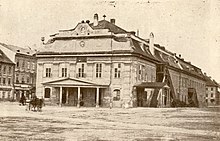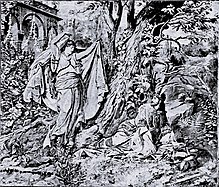Slovak National Theater


The Slovak National Theater ( Slovenské národné divadlo in Slovak ) in Bratislava (German Pressburg, Hungarian Pozsony) is the oldest theater in Slovakia . It was founded in 1920 after the independence of what was then Czechoslovakia . Its predecessor was the Municipal Theater of Pressburg.
history
The first theater in front of the fishing gates
In the place of the old building of today's Slovak National Theater there was already an older building. Until 1884 it was the first theater building in Bratislava. Count Georg Csáky had this building built at his own expense. The planning work was carried out by the builder Matthäus Walch. In 1774, the ground for a new theater building began to be excavated in front of the Fischertor . Individual wealthy families in the city rented (hereditary) family lodges, which meant that part of the construction costs could be covered. On November 29, 1775, Empress Maria Theresa personally checked the progress of the construction work. On April 7, 1776, Christian Hieronymus von Moll took over the management of the theater. The official opening took place on November 9, 1776 with the play Die Medizeer by Johann Christian Brandes . The Preßburger Zeitung wrote: The crowd of spectators was as big as one could ever expect at such a celebration ... On November 16, Duke Albert of Saxony Teschen and Archduchess Maria Christina , on November 22, Maria Theresa visited the theater . The Preßburger Zeitung wrote: ... as soon as they entered the magnificent court box that had actually been built, the audience, gathered in an indescribable crowd, was delighted with the very high presence of this most dear national mother, which was expressed no other than by a general clapping of hands and shouts of viva could be.
The theater had a very good reputation; Well-known actors from Vienna such as Rudolf Tyrolt and Bernhard Baumeister also make regular guest appearances in Pressburg. In 1879 Alexander Girardi made his first guest appearance in the Pressburg Theater and then started his way to world success from here.
This theater served the people of Pressburg for over a hundred years. In the last quarter of the 19th century it became dilapidated, it would have been too expensive to renovate and therefore had to be demolished in 1884. The terrible fire in the Ringtheater in Vienna in December 1881, which killed several hundred people, was also decisive for the rapid cessation of theater operations . At that time, during the presentation of Hoffmann's stories from Offenbach, gas leaked out due to defective gas lighting, which led to the explosion. Immediately after this disaster, the ministry issued an order to improve security, and additional exits with wooden stairs should be created. Since this project did not seem feasible, the house was given up and it was decided to build a new one.
The second theater (rebuilt in 1886)
After the decision of the city administration to build a new city theater, the architects Ferdinand Fellner d. J. and Hermann Helmer approved the plans drawn up and released for implementation. The construction was carried out by Ignaz Feigler the Elder. J. The cost of the construction was 340,000 guilders and the auditorium was lit by 800 gas lamps and offered space for 611 spectators. The last work inside was completed in August 1886 and the theater was ceremoniously opened on September 22, 1886. In the opening performance, a festival march by the Hungarian composer Sándor Bertha - composed especially for the occasion - was performed. This was followed by a 'prologue' Lidércfény ( Eng . "Irrlicht") by the Hungarian writer Maurus Jókai . The evening was musically directed by the Hungarian composer Sándor Erkel. Following the 'Prologue', the Hungarian national opera Bank Bán (music: Ferenc Enkel, libretto : Béni Egressy ) was performed by the ensemble of the 'Royal Hungarian Opera House' Budapest.
The Pressburger Zeitung reported on this event in detailed reports on September 22nd and 23rd, 1886.
The foyer and the walls of the theater were designed by Willibald Leo von Lütgendorff-Leinburg . In front of the theater is the artistically valuable Ganymed Fountain, the work of the Bratislava sculptor Viktor Tilgner .
Until the collapse of Austria-Hungary
Below the cornice , five figure niches were made in the central part of the building. The busts of JW von Goethe , William Shakespeare , Franz Liszt , József Katona and Mihály Vörösmarty by the Viennese sculptor W. Marhenke were housed in these . In 1936 the busts were removed for ideological reasons, as they were to be replaced by Czech and Slovak personalities. This plan was not implemented, the niches remained empty. For decades the busts lay unnoticed in some depot in the city. In 1972 they were taken over by the Slovak National Gallery . Copies were made, which were put back in their original place after the political changes in 2003. Only the bust of Vörösmarty had to be replaced by a new one ( WA Mozart ), as it was lost over the decades. Until the collapse of Austria-Hungary , mainly German and Hungarian-language pieces were performed. In 1902 an “ensemble guest performance of the Bohemian Opera in Brno ” took place here. It had only happened for the second time since the theater in Bratislava was founded that it was performed in a Slavic language. The Brno Opera opened the opera cycle with the Bartered Bride by Bedřich Smetana ; the tour lasted about two weeks.
- v. Lütgendorff's mural in the foyer
The time after 1918
The occupation of Pressburg by the Czechoslovak legionnaires on New Year's Eve 1918/1919 initially had no impact on theater operations. The Slovak National Theater started its regular performances later. The first piece, which was performed on March 1, 1920 in the Slovak National Theater, was the opera Hubička ("The Kiss") by the composer Bedřich Smetana. The Slovak National Theater was then taken over by the "Slovak National Theater Society", which was formed in the second half of 1919 under the chairmanship of Vavro Šrobár . One of the first directors of the theater was Oskar Nedbal (from 1923 to 1930). Before the Slovak Philharmonic was founded, concerts were given in the theater.
Since its inception, the theater has had its home in the historic building on Promenade Square , today's Hviezdoslav Square . ( Location ).
Today the Slovak National Theater combines the stage arts of drama , opera and ballet .
New house on the banks of the Danube
On April 14, 2007, the new theater building was inaugurated on the edge of the city center near the banks of the Danube ( location ), but two other buildings built after the Second World War were given up. The opening ceremony was celebrated in the presence of numerous representatives of public life and to the sound of the symphonic poem Also sprach Zarathustra by Richard Strauss from the President of the Slovak Republic Ivan Gašparovič . At the opening, the Slovak National Opera Krútňava by Eugen Suchoň was originally supposed to be performed, but the performance had to be postponed because the main actor was unable to perform.
The first impulses for the construction of a new building for the Slovak National Theater go back to 1959. In 1980 the architects Peter Bauer, Martin Kusý and Pavel Poňák won an architecture competition; for various (political but also financial) reasons, however, the construction work was delayed by 27 years.
Today the Slovak National Theater is one of the most modern of its kind. Three theater halls are combined in one building: Opera 901 seats, Drama 635 seats, small studio: 192 seats. The house also has numerous ancillary rooms (restaurant, dining room for the staff, etc.). The total built-up area is 46776 m². In the modern new building, all branches of the theater are now united, which had to be spread over several houses in the previous decades. At the same time, the old theater on Hviezdoslav Square will continue to be used.
literature
- Karl Benyovszky : The old theater. Cultural-historical study from the past of Bratislava , Pressburg: Angermayer 1926.
- Emil Portisch: History of the City of Pressburg-Bratislava, 2nd vol. Pressburg-Bratislava 1932/1933, vol. II., P. 241ff.
- Karl Benyovszky: Bratislava-Pressburg in words and pictures. A guide through the capital of Slovakia , Bratislava: Steiner 1938, p. 59.
- P. Rainer Rudolf, Eduard Ulreich: Karpatendeutsches Biographisches Lexikon. Working group of the Carpathian Germans from Slovakia, Stuttgart 1988, ISBN 3-927096-00-8 .
Web links
- Site of the Slovak National Theater
- Information about the Slovak National Theater
- SME.sk Petit Press, as of April 16, 2007, online http://korar.sme.sk Nova-budova-snd -... (Slovak, accessed October 24, 2017)
Individual evidence
- ↑ Matthäus Walch was born in Bösing . He was the only famous builder of the 18th century who came from the area around Pressburg . In 1757 he settled in Pressburg. In 1776 he built the Great German Evangelical Church on the Nonnenbahn. He also built the Jesuit order house , the (old) municipal theater in Pressburg, and the Pressburg palaces of the Erdődy and Illesházy families . His work was under the influence of FA Hillebrand . (Source: Karpatendeutsches Biographisches Lexikon. Stuttgart 1988, p. 343)
- ^ Preßburger Zeitung of November 23, 1776
- ↑ Left in the picture: the 'Kern'sche Haus'. In 1845 the Pressburg innkeeper Andreas Kern had the architect Ignaz Feiger the Elder. Ä. ( Feigler (family) #Ignaz Feigler the Elder ) build a four-storey house in the Empire style in which he set up his guest house "Zum Blumenstöckel". Right in the picture: In memory of an earthquake, a column dedicated to St. Joseph was erected on the (small) promenade in 1715 , which was renovated in 1764 and 1830. After 1945 the communist rulers of the people's democratic Czechoslovakia had this statue removed. (quoted from Karl Benyovszky: Bratislava-Pressburg in words and pictures. A guide through the capital of Slovakia , Bratislava: Steiner 1938, p. 61)
- ↑ quoted in: Ovidius Faust : Príbehy zu starej Bratislavy, Bratislava 2017, p. 82 (Slovak)
- ^ Sándor Bertha (born August 19, 1843 in Pest , † November 24, 1912 in Paris ) was a Hungarian composer and piano virtuoso .
- ↑ Sándor Erkel (born January 2, 1846 in Ofen , † October 14, 1900 in Békéscsaba ) was the youngest son of the composer Ferenc Erkel .









